Bulletin – September 2011 The Domestic Market for Short-term Debt Securities
- Download the article 295KB
Abstract
The market for short-term debt is dominated by the issuance of bank securities. Yields on these securities act as an important reference rate within the financial system. The turmoil in global markets during recent years has led to significant changes in the short-term debt market as the funding profiles of banks and other issuers of short-term securities has altered.
Introduction
Short-term debt securities are those issued with less than 12 months to maturity. They play an important role within the domestic financial system, both as a source of liquidity for the banking sector and as a pricing benchmark for a wide range of contractual obligations. This article considers how the composition of the short-term debt market has altered in recent years and how prospective regulatory initiatives may bring about further changes. The main developments that have occurred are a significant shift in the pattern of bank funding, a reduction in issuance by securitisation vehicles and the reintroduction of Treasury notes by the Australian Government.
Banks' Issuance
Within the Australian market, the banking sector is the predominant issuer of short-term debt securities, through the sale of certificates of deposit (CDs) and bank accepted bills (Table 1).
| As at 30 June 2011 | As at 30 June 2007 | ||||
|---|---|---|---|---|---|
| $b | % of total | $b | % of total | ||
| Issued by: | |||||
| Banks | |||||
| as bank accepted bills | 21.7 | 8.7 | 81.1 | 24.8 | |
| as CDs | 180.9 | 72.2 | 181.1 | 55.4 | |
| AOFM (as Treasury notes) | 16.0 | 6.4 | 0.0 | 0.0 | |
| State and territory government authorities (semi-governments) | 12.0 | 4.8 | 6.1 | 1.9 | |
| Securitisers (as asset-backed commercial paper) | 13.8 | 5.5 | 25.2 | 7.7 | |
| Other corporations | 6.2 | 2.5 | 33.6 | 10.3 | |
| Total | 250.6 | 100.0 | 327.1 | 100.0 | |
|
Sources: ABS; AOFM; APRA; Austraclear |
|||||
Bill facilities are an important means by which banks extend credit to businesses. By ‘accepting’ a bill of exchange drawn by one of its customers, the bank extends credit to the customer and guarantees repayment at maturity to the holder of the bill. Bill acceptances account for around 20 per cent of bank lending to business and, as with overall business credit, acceptances have fallen since early 2009 (Graph 1).

To fund the extension of credit made to the drawer of a bill, the bank may sell the acceptance into the market. However, in recent years, banks have increasingly preferred to retain most of their acceptances within their own portfolios, such that the outstanding stock of bills sold to investors is now less than $25 billion, compared with $128 billion of total acceptances.
While bill facilities tend to function as revolving lines of credit, customers generally draw bills with quite short maturities, such as one month. In the expectation that further credit is likely to be extended at the bill's maturity, banks prefer to fund themselves at longer maturities than the bills that they have accepted. Reflecting this, most short-term debt securities issued by banks now tend to be certificates of deposit (Graph 2).[1] As at June 2011, there was $181 billion in bank CDs outstanding.
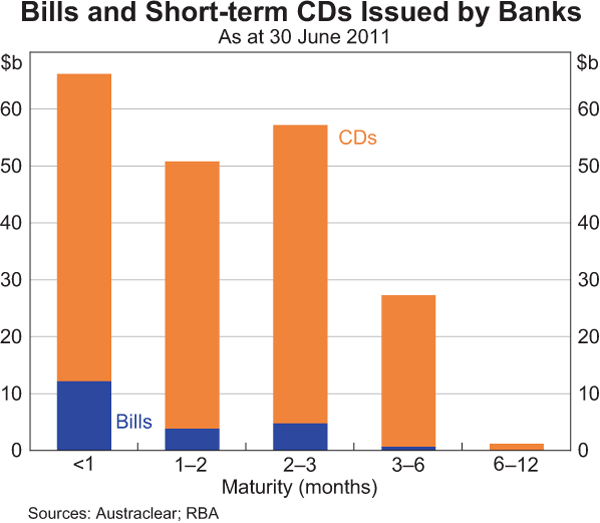
Since 2004, bank bills and CDs issued by authorised deposit-taking institutions (ADIs) have been eligible for sale under repurchase agreement (repo) to the Reserve Bank in its market operations, as a means of providing liquidity to the owner of the securities. The Reserve Bank does not purchase these securities on an outright basis and repos are only contracted with counterparties that are not related to the issuer of the security.[2] As securities that are eligible for sale to the Reserve Bank count as liquid assets under APRA's prudential liquidity requirements, ADIs have been able to hold other entities' bills and CDs in fulfilment of these requirements. At present, around one-third of the bills and CDs sold into the market are held by other ADIs (Graph 3).
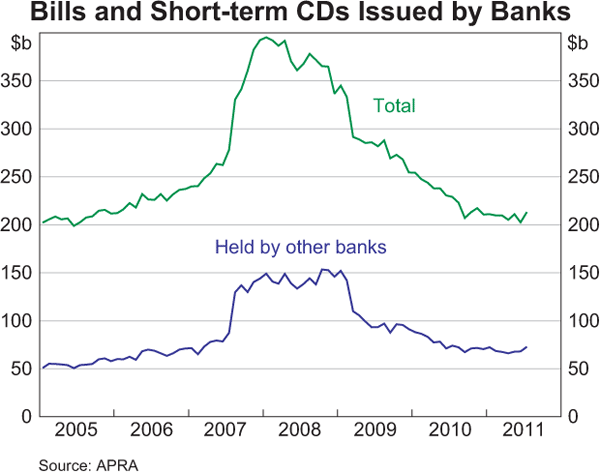
The importance of bill and CD holdings as a source of liquidity was highlighted by the banks' response to the emerging financial crisis in mid 2007. Issuance of CDs rose sharply, with most new securities issued to other ADIs. This gave ADIs greater scope to source liquidity from the Reserve Bank, were it to be needed. However, when the financial crisis reached its peak after the collapse of Lehman Brothers in late 2008, ADIs were permitted to securitise residential mortgages they held on their books and sell these ‘internal securitisations’ to the Bank under repo. These arrangements – which remained in place until mid 2009 – lessened the need for cross-holdings of CDs and issuance of those securities consequently declined.[3]
Since that time, CD issuance has continued to fall. To some extent, this reflects the efforts that ADIs have made toward extending the maturity of their liabilities by issuing more longer-term debt securities. However, the main adjustment in bank funding has been a switch from short-term securities to deposits of similar maturity.
Several factors appear to have driven this change, on both the demand and supply sides. Firstly, the role of cash management trusts within the financial system has declined, particularly since the Australian Government introduced a guarantee on deposits (of up to $1 million) in late 2008. These trusts were significant investors in CDs.
Secondly, the financial market turmoil of recent years has resulted in market participants viewing deposits as a more stable source of funding than negotiable instruments. To a certain extent, this is consistent with the proposed Basel III liquidity reform measures. Under Basel III, ADIs will face more stringent liquidity regulations than at present, requiring them to hold liquid assets against their projected net cash outflows in a 30-day stress scenario. In that scenario, certain deposits (such as those placed by retail and non-financial corporate customers) are assumed to ‘run-off’ at a slower rate than maturing securities. In response, to reorient their funding base along these lines, ADIs have been prepared to pay a higher premium for deposit funding, increasing the rates they pay on deposits relative to those paid on bills and CDs. As a consequence, non-financial corporations have reduced their purchases of short-term securities and increased their placements of deposits (Graph 4, left-hand panel). Similarly, financial entities (such as pension funds) are now also much more likely to place deposits with ADIs than purchase negotiable instruments such as CDs. (Under Basel III, however, deposits from those sources are assumed to run-off at the same rate as maturing securities.)
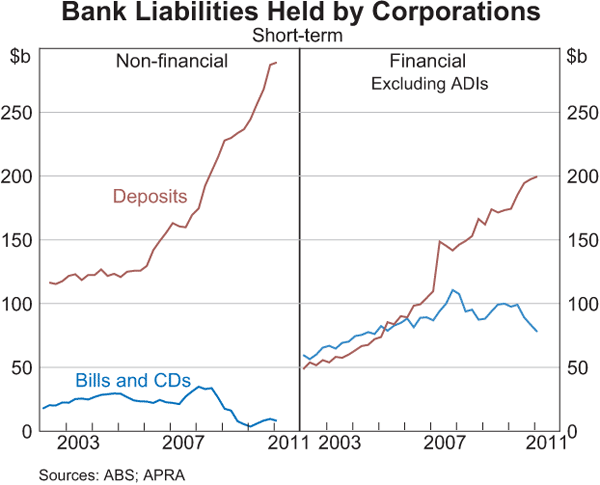
Going forward, other aspects of the Basel III measures may also affect the market for bills and CDs. The requirement to hold liquid assets against all securities maturing within 30 days may remove the incentive for ADIs to issue any debt securities with less than 31 days to maturity. Additionally, only cash, balances held at the Reserve Bank, Commonwealth Government securities (CGS) and securities issued by the state and territory central borrowing authorities will qualify as liquid assets in the Australian market. Holdings of certain private securities – such as bills and CDs – may still count toward an ADI's liquidity requirement, but only if the ADI has paid a fee to ensure access to the Reserve Bank's committed liquidity facility.[4]
Trading in Bank Bills and CDs
Within the market for bank bills and CDs, a distinction is drawn between ‘prime’ and ‘non-prime’ banks. The determination of prime banks is overseen by the Australian Financial Markets Association (AFMA) through an annual selection process conducted amongst money-market participants. Prime banks need to be of a high credit quality and with a sufficiently large issuance program so as to promote liquidity. Currently, there are six prime banks: ANZ, BNP Paribas, CBA, JPM Chase, NAB and WBC. These banks all have long-term debt ratings of AA- or better and, at close to $150 billion, their bill and CD issuance accounts for around 70 per cent of the market.[5] As much as one-third of prime bank issuance is likely to be held within the interbank market.
The purpose of designating certain banks as ‘prime’ is to create a homogenous group of liquid securities. Within the interbank market, most of the trading in prime bank bills and CDs is conducted via brokers. When posting bids and offers, buyers and sellers do not specify a particular bank; they are simply dealing in prime bank debt. A buyer is presumed to be indifferent between receiving bills or CDs issued by any of the prime banks.[6]
To promote liquidity in the market further, securities are grouped into maturity buckets corresponding to the first and second half of each month (‘early’ and ‘late’ securities). Thus, an investor looking to purchase three-month bills or CDs on the 1st of September would be bidding for early December paper and, if successful, could receive any bill or CD issued by a prime bank maturing between the 1st and the 15th of December. This feature naturally influences the pricing of bank bills and CDs. When bidding, the buyer will assume that the seller will deliver the security that it is most in the seller's interest to deliver. For example, when the yield curve is upward sloping, for a given rate the seller would rather deliver a longer maturity security. In this environment, bills and CDs maturing in, say, the first half of the month, will be priced as though they mature on the 15th.
Interest rates on prime bank bills and CDs act as key reference rates in the domestic market, not just as a pricing benchmark for other short-term debt securities, but also for determining the payment obligations due on long-term floating rate debt and on a range of derivatives, such as interest-rate swaps, cross-currency swaps and forward-rate agreements. The specific reference rates used are known as bank bill swap reference rates (BBSW) and their compilation is overseen by AFMA. Each trading day, AFMA surveys market participants for rates on prime bank bills and CDs for maturities ranging from one to six months.[7] Survey respondents report where these securities are trading in the market at 10 am.[8] This method is very different to that used by the British Bankers' Association when deriving LIBOR (see Box A).
As BBSW is set at 10 am, most of the trading activity in bills and CDs tends to occur at this time. Liquidity is generally greatest at the three-month maturity, with between $0.5 billion and $1 billion in securities turning over most days in the interbank market. Trading tends to be particularly active towards the end of each half-month period. As the liquidity of a three-month bill or CD declines noticeably when its maturity effectively drops to two-and-a-half months, market participants may look to close out their trading positions ahead of that time.
Box A: LIBOR
Each trading day, the British Bankers' Association (BBA) publishes interbank borrowing rates in the London market for 10 currencies, including the Australian dollar. These rates are known as London Interbank Offer Rates (LIBOR).
Respondents to the BBA's survey report where their institution has borrowed, or potentially could borrow, in the unsecured interbank market for maturities ranging from overnight to 12 months. The BBA's calculations are therefore reliant on the respondents reporting accurate data about their own (actual or potential) borrowings. Partly reflecting the disparate credit standings of the respondents, there can be a reasonably wide variation amongst the contributions. This contrasts with BBSW, where respondents report the current trading levels of other institutions' debt, most of which is occurring transparently over brokers' screens. Consequently, there is almost always a high degree of correspondence between the individual contributions to the BBSW survey.
In recent times, there have been concerns expressed about the reliability and integrity of the LIBOR fixings.[a1] During the period of turmoil in global markets in 2008 and 2009, unsecured interbank lending for all but the shortest maturities was significantly curtailed in many currencies. As a consequence, many respondents may have been reporting rates that did not correspond to any actual (or even potential) borrowings. As to whether contributing banks could have submitted rates purposefully designed to influence the LIBOR fixings in a manner beneficial to their firm (perhaps because they held derivative or other positions whose payoffs were linked to the LIBOR fix), the BBA stress that for each rate, the ranked responses are trimmed of their top and bottom quartiles and then averaged to produce the LIBOR fixing. In the Australian context, to manipulate the BBSW rate set, an institution would need to manipulate the traded market directly.
Australian dollar rates are provided to the BBA by eight banks who operate in the London market for Australian dollars. Unsecured borrowings in this market are generally quite limited, however. Much of the offshore interbank borrowing and lending of Australian dollars takes place via foreign exchange swaps, whereby funds are exchanged against another currency (usually, US dollars) with an agreement to unwind the exchange at a future date. In this way, Australian entities that raise short-term funds offshore (such as ADIs and the states' central borrowing authorities) generally borrow in a foreign currency and swap the proceeds back into Australian dollars. Reflecting this, while LIBOR fixings are used as the principal reference rates in currencies such as the British pound, the Swiss franc and the US dollar, Australian dollar LIBOR does not have a comparable status. Rather, BBSW is used as the interbank reference rate for most Australian dollar derivatives and other financial instruments.
Government Securities
In March 2009, the Australian Office of Financial Management (AOFM) recommenced the issuance of Treasury notes on behalf of the Australian Government, more than five years after all previously issued notes had matured (Graph 5). Treasury notes are short-term CGS and are principally used to smooth the intra-year variation in the Government's financial position. Accordingly, the volume on issue can fluctuate appreciably. In the 2010/11 year, for example, Treasury notes outstanding ranged between $10 billion and $20 billion.
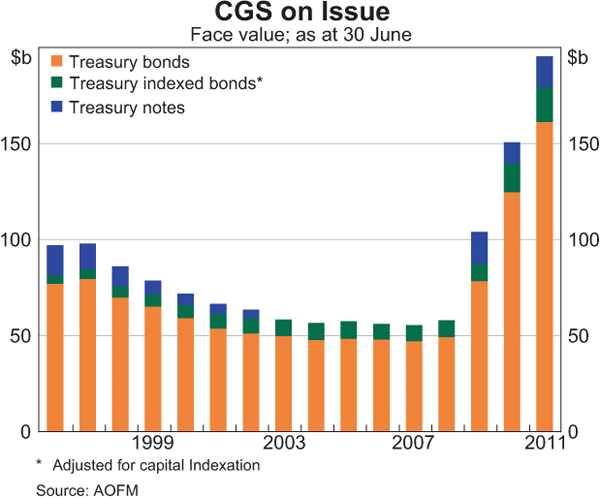
In the decade or so before 2008/09, consistent budget surpluses meant that the Australian Government accumulated significant financial assets (principally, deposits at the Reserve Bank). Instead of issuing Treasury notes, asset holdings were allowed to rise and fall so as to offset the short-term fluctuations in the Government's financial position arising from the intra-year cycles in receipts and payments. Unlike the role played by Treasury bonds in the longer-term debt market, Treasury notes are not the principal reference rate within the money market. As noted above, that function is performed by interbank rates (namely, BBSW), as it is in most overseas markets. Hence, while successive Governments have committed to maintaining a sufficient supply of Treasury bonds in order to provide a ‘risk-free’ curve for long-term interest rates, the supply of Treasury notes has been allowed to vary (and even cease) as the Government's financial position has varied.
At present, Treasury notes are generally offered at tender once per week. Investor appetite was somewhat variable when Treasury notes were initially reintroduced, but, consistent with their risk-free status, yields on these securities are now generally well below other short-term interest rates (Graph 6), with strong demand from offshore investors such as foreign central banks. To aid liquidity in these instruments, the AOFM now structures its issuance toward having large individual notes, with no more than one note maturing in any half-month period.
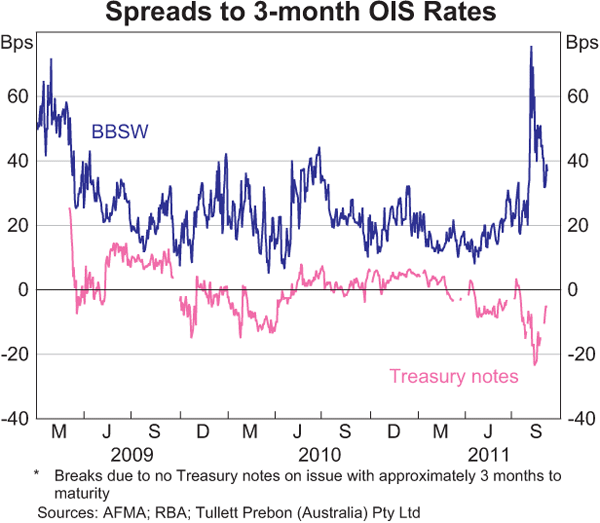
The central borrowing authorities of the states and territories also issue short-term debt securities.[9] Most ‘semi-government’ authorities appoint a panel of dealers through which they sell their notes and/or commercial paper. While some authorities tender set amounts, others sell via ‘reverse enquiry’; that is, they respond to indications of demand that the dealers have received from their investor clients. Reflecting the benchmark status of prime bank bills and CDs, rates on semi-government short-term debt securities tend to be set at a margin to BBSW, with the spreads below BBSW tending to be somewhat less than those implied by Treasury note yields.
As at 30 June, there was $12 billion in semi-government short-term debt on issue in the domestic market (although, as with Treasury notes, the outstanding volume can vary substantially through the year). In addition to their domestic issuance, the semi-government authorities also maintain offshore commercial paper (CP) programs. This CP is also issued through dealer panels, but is generally denominated in foreign currencies with the proceeds swapped back to Australian dollars.
Other Short-term Debt Securities
The domestic market for asset-backed commercial paper (ABCP) had grown steadily throughout much of the past decade, with most issuing entities (often known as conduits) acting as warehouses for residential mortgages purchased from a range of originators. However, as with securitised asset markets in general, the market for ABCP was adversely affected by the dramatic reassessment of risk that, from mid 2007, brought about a prolonged period of turmoil in global markets. Initially, domestic issuance rose sharply as the conduits, facing increasingly difficult conditions in Europe and the United States, reoriented their funding onshore (Graph 7). Subsequently, as the domestic market for ABCP also deteriorated, conduits were forced to draw on their back-up liquidity facilities with sponsoring banks.[10]
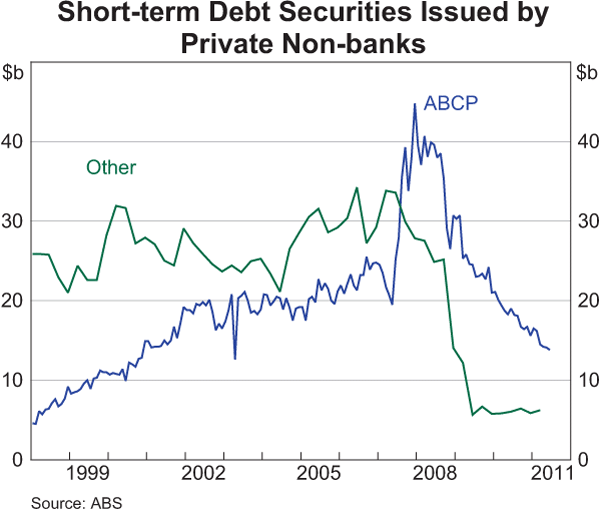
Although a number of programs remain in operation, issuance of ABCP has continued to decline. In part, this reflects a reduction in the supply of assets typically purchased by the conduits (such as mortgage originator loans). Additionally, with investor demand for ABCP slow to recover, the issuance of many conduits has fallen in line with the ongoing amortisation of the loans held by them. The credit ratings for many of the domestic ABCP programs have also been lowered since the period of market turmoil.
The financial crisis also brought lasting structural change to the issuance of commercial paper by other non-bank entities. The funding difficulties encountered during 2008 and 2009 prompted several major issuers to permanently cease their lending activity in particular markets (such as car dealer finance), with their CP programs scaled back accordingly. Similarly, several of the financing companies affiliated with banks ceased issuing debt into the market in their own name and now either obtain funding directly from their parent bank or have had their financing activity brought onto the parent bank's balance sheet.
Box B: Overnight Indexed Swaps
Interest rate swaps are derivatives in which one party agrees to exchange fixed (‘swap’) rate payments on a notional amount against receipts determined by a floating (reference) rate applied to the same amount. In the Australian market, overnight indexed swaps (OIS) are swaps referenced to the cash rate – the rate on unsecured loans in the overnight interbank market.
In contrast to yields on debt securities, swap rates cannot strictly be thought of as rates of return, as a swap involves no upfront investment of funds. To earn the OIS rate, an investor would need to receive the fixed rate in the swap and separately place funds equal to the notional amount of the swap in the overnight cash market each day for the duration of the swap. The interest receipts from these overnight loans would offset the floating rate payments that are made in the swap. As such investments in the interbank market incur credit risk, OIS rates are therefore not ‘risk-free’ rates. However, each day, the investor can decide anew which bank to place funds with. In this regard, overnight bank lending through the life of the swap is less risky than lending to the one bank for the full term. For this reason, OIS rates are usually below the rates on unsecured bank debt (such as bills and CDs) of equivalent maturity (Graph 6). From the borrowing bank's point of view, the spread represents the cost of converting their funding from overnight to term maturity. During the financial turmoil of 2008 and 2009, these spreads became elevated as investors demanded considerable premiums for term lending.
As the cash rate is the operational target for the Reserve Bank's monetary policy, banks use trades in OIS to hedge their interest rate exposure. Others may use OIS to speculate on the near-term direction of the cash rate. For these reasons, OIS rates generally provide the most direct means of gauging market expectations for the future course of monetary policy.[b1] For example, just prior to the Reserve Bank Board meeting in June 2011, one-month OIS was quoted at 4.80 per cent (Graph B1). As the existing cash rate target was 4.75 per cent, this implied that market participants saw some chance of an increase in the cash rate during the coming month.[b2] Subsequently, OIS rates have declined, suggesting that market participants expect a near-term easing in monetary policy.
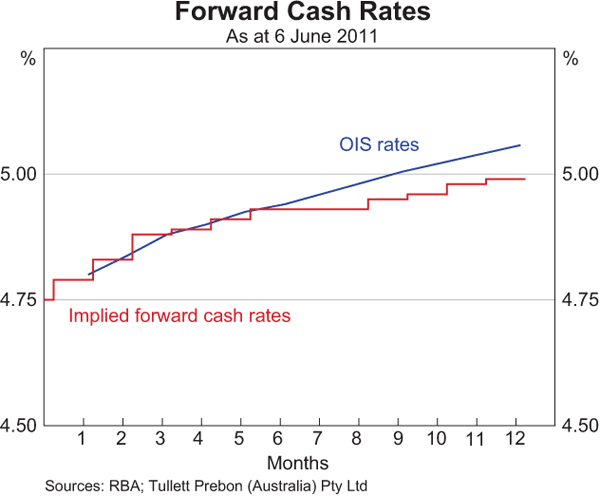
Inferring expectations about the future cash rate from the OIS curve can be problematic, however. Investors who lock in an interest rate for longer maturities may demand compensation in the form of higher rates. In this sense, forward cash rates may exceed cash rate expectations by a ‘term premium’.[b3]
Various statistical techniques can be used to try to extract such a premium, although it is difficult to gain reliable estimates.[b4] Furthermore, movements in OIS rates (and, indeed, in many interest rates) can at times be exaggerated when large shifts in the positions of market participants overwhelm the available liquidity in the market. The dramatic fall in OIS rates during August 2011 may be one instance of such an occurrence.
Conclusion
The domestic money market is dominated by bank bills and CDs, principally those issued by the prime banks. The importance of prime bank securities is further enhanced by the reference role that BBSW plays in determining settlement amounts on derivatives and other contractual payments. Recent structural changes have diminished the relative supply of bank bills and CDs and forthcoming changes to the liquidity regulations imposed on ADIs may further alter the market. Since the financial crisis, there has also been a reduction in issuance by securitisers and other private non-bank entities, while changes in the Australian Government's financial position have seen Treasury notes reintroduced into the market.
Footnotes
The authors are from Domestic Markets Department. [*]
Several ADIs issue CDs with terms to maturity exceeding 12 months. These CDs are not included in the analysis or data presented here. Long-term CDs (such as ‘transferable’ CDs) often pay regular coupons, whereas all the securities discussed in this article are zero-coupon (or discount) instruments. Unlike deposits, CDs (of whatever maturity) are not ‘protected accounts’ under the Banking Act 1959, and are therefore not covered by the Financial Claims Scheme. [1]
A repo is an agreement between two parties under which one party sells a security to the other, with a commitment to buy back the security at a later date for a specified price. [2]
While internal securitisations remain eligible for the Reserve Bank's market operations, since mid 2009, the Bank has only been willing to purchase these securities under repo in ‘extraordinary’ circumstances. [3]
The Reserve Bank's proposed committed liquidity facility will permit ADIs to sell eligible securities to the Bank under repurchase agreement. The eligible securities will correspond to those deemed eligible for the Bank's market operations. [4]
Excepting JPM Chase, bills and CDs issued by the prime banks are those able to be delivered in settlement of a position in the Sydney Futures Exchange's (SFE) 90-day bank bill futures contract. [5]
Although market convention permits a buyer to reject a trade within 10 minutes of execution if they lack sufficient credit limit for the name offered, it is extremely rare for buyers to exercise this option. [6]
Prior to 2009, AFMA also calculated 9- and 12-month BBSW. However, the contraction of issuance at these maturities during the financial crisis prompted AFMA to discontinue their calculations. [7]
AMFA also conducts an end-of-day rate set for prime bank bills and CDs. While the process is identical to that used for BBSW, these 4.30 pm rates are generally only used for mark-to-market purposes and do not have the profile of the earlier rate set. Reflecting this, end-of-day trading is considerably less active than at 10 am. [8]
For more details on the debt programs of the central borrowing authorities, see Lancaster and Dowling (2011). [9]
For an overview of the Australian ABCP market, see Black and Fisher [10]
Footnotes Box A
For a discussion, see Gyntelberg and Wooldridge (2008). [a1]
Footnotes Box B
Similar information can be gleaned from the SFE's 30 day interbank cash rate futures, which are also indexed to the cash rate. [b1]
At the termination of an OIS, the floating rate payment due will be equal to the compounded cash rate over the term of the swap. Because of this compounding, OIS rates will exceed the arithmetic average of the forward cash rates (as in Graph B1). [b2]
Note that this term premium (which reflects compensation for interest rate risk) is conceptually distinct from that alluded to above when discussing spreads between bank bill and OIS rates. That premium reflects compensation for the additional credit and/or liquidity risk involved in purchasing term funding instruments such as bills. The ‘term’ risk embedded in OIS (which is a derivative, not a funding instrument) only relates to interest rate risk. [b3]
Theoretically, there is no reason why this premium may not be negative. However, empirical studies, both on Australian dollar and foreign currency interest rates, generally find that the term premium is positive. [b4]
References
Black S and C Fisher (2008), ‘The Asset-backed Commercial Paper Market’, RBA Bulletin, January, pp 1–10.
Lancaster D and S Dowling (2011), ‘The Australian Semi-government Bond Market’, RBA Bulletin, September, pp 49–54
Gyntelberg J and P Wooldridge (2008), ‘Interbank Rate Fixings During the Recent Turmoil’, BIS Quarterly Review, March, pp 59–72.